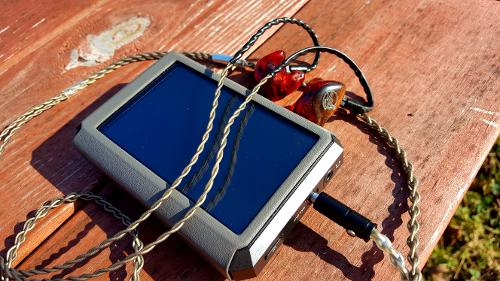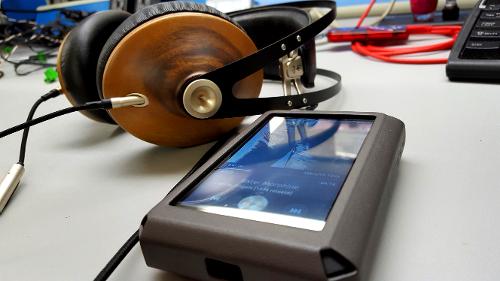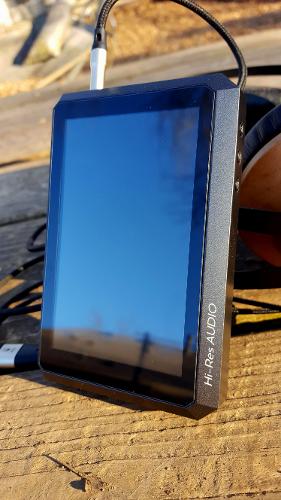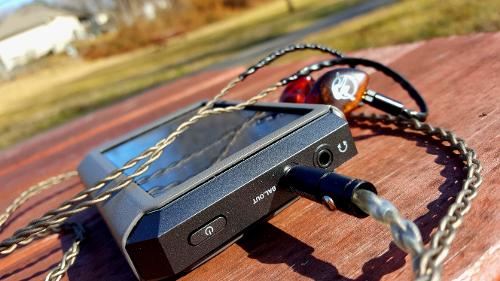
I give Nik (AKA
nmatheis) many thanks for lending me his own personal unit for this review. This device opened my eyes and changed my thinking on a number of things, and for that, he has my deepest gratitude.
I spent a little over a week with the Opus #1, by theBit (or Audio-Opus, depending on what you read). This was not a DAP I pursued. I didn’t join any tours, for there were none to join. The opportunity merely came along, and I thought, “Hell, why not?” What serendipity, that what amounted to a text-based shrug, would land in my lap one of the best players I’ve ever heard.
But I’m getting ahead of myself. Let me talk about the build first.

It’s solidly made. That’s the extent of my praise. It’s sturdy. It won’t fall apart on you. The buttons work. The screen works. Everything works. But it’s so boring! Where’s the artistry? Where’s the flare? Look at the Cayin i5. It’s so pretty! I want to touch it when the lights go out. That’s the sort of reaction I want from a DAP: carnal desire! I guess I have a DAP that does this for me. It’s called the AK120II. Astell&Kern spoiled me with the level of luxury they offer. Of course, they charge you a premium for it. But Cayin doesn’t. The N5, and now the i5, are stunning, and reasonably priced.
theBit could learn a lot from them.
In my portable music players, I’m more than a little obsessed with volume wheels. They delight me something fierce. I flat out won’t buy another DAP without one. And it seems I won’t ever have to. They’re all moving in that direction now. Or at least a good many of them are. The Opus #1 doesn’t have a volume wheel. Ok. I’m a big boy. I can deal for a week. But that’s not its biggest sin. It’s that the buttons aren’t easy to use. They’re small, and if you have the case on, there are no cut-outs, just impressions stamped into the material. This makes for some clumsy use of the hardware interface.
It’s not an indomitable burden. Nothing like on the scale of the FiiO X5 Classic’s scroll wheel. No, the Opus #1’s hardware just reminds you in small, subtle ways that it’s not as fancy or as nice as other players. That’s a d@mn shame, because it doesn’t sound anything less than a top of the line product.

There isn’t an over-abundance of features to cover. Which is good for Pinky’s stats, since I’m not going to cover even half of the features the Opus does possess. Still, a few items caught my attention.
There are two slots for external microSD cards, in addition to 32GB of internal storage. That came as a great surprise, and I immediately gave it extra points for being so thoughtful. It’s amazing how rare that is these days. It has Balanced output, which, at the very least, I found convenient, since so many of my cables are terminated for 2.5mm TRRS. The Opus #1 sports one of the best Deep Sleep modes. When I first opened the package, the device turned On instantly. It had been On during transit, and yet it was close to a full charge. Sleep Mode is so efficient I never felt the need to turn the DAP Off, and the battery did not drain to any noticeable degree.
As great as Sleep Mode is, you will drain the Opus #1 through hard use. When you do, I am happy to say, it charges very fast. But only when powered up. I don’t think it charges at all when shut off. Even from the USB port on your PC, it takes just a few hours to reach Full. My AK120II takes many more hours to charge, when not using a wall-socket adapter.
The software UI is simplistic yet feature-rich. Finding the settings menu took a few frustrating minutes, however, but I eventually figured it out. You swipe down. Of course you swipe down. But you must swipe fast, because if you hold your finger at the top for even a full second, swiping down only brings up the time and date. That is useless. That information is also present in the full drop-down screen. So making it its own screen only confuses what should be an easy procedure.

Alright. I don’t want to talk any more about features. It’s a fairly bare-bones Android Device, after all. This thing doesn’t care about anything but audio performance. And that just so happens to be what I want to talk most about.
Since I complain so much about DAPs trying to be Smartphones, I feel I ought to give theBit kudos. The Opus #1 does not suffer from a development whose focus and resources were divided and ultimately squandered on idiocy. There is no Bluetooth. No WiFi. No Apps Store. All their money and energy went into sound quality. And OH GOD does it show!
Upon first hearing the Opus #1 by theBit, Pinky’s dwindling follicles were not blown back in awe. It sounded digital and artificial to me, like many budget-fi and mid-fi products. Then I listened to another album, and another, and realized the Opus merely reveals exactly what is recorded, and does so with powerful fidelity. SEA CHANGE by Beck uses a lot of digital filters, and I could hear those filters in vivid detail. Moving on to The Rolling Stones, and you hear all the analogue distortions they use to create their iconic sounds. You listen to an artist who records clean and you get crystal clarity.
In truth, this device is 100% free of inherent harshness or digititis. It feeds your headphones only what is contained within the source file. It is quite neutral, but not the dry, or thin neutral you sometimes get. The Opus is fuller and livelier than, say, the FiiO X7. Yet just as detailed and revealing. The dynamics on display here are top shelf. There is better treble sparkle than I hear on the Astell&Kern AK120II, and maybe a little harder punch down below.
The AK120II is warmer, overall. There is lushness, found most notably in the vocals. It’s thicker, with more weight to the notes. On the Opus the vocals sound thin, but not in that bad way. They are so clear and vibrant that I don’t care if they lack some of that weight the AK produces. In the bass department, either one has ample power. They both sound rich and natural, and very detailed. Due to its brighter treble though, the Opus will seem more detailed.
The soundstage on the AK is wider. I couldn’t tell any difference at first, not until I played my 24bit masters of The Beatles. Those have a great sense of space, and as I switched between the AK and Opus, the difference is plain to hear. But on Led Zeppelin IV, I heard no change. Take this as evidence of just how good the soundstage is on the Opus. It’s properly expansive. Only in extreme scenarios does it fall a little behind.
Despite their enormous price difference, I can’t honestly say which is better. I listened critically, using an A/B switcher, and I feel my choice would come down to signature preference, or headphone pairing. In spite of how much it pains me to admit, there is nothing about the audio capability of my AK that bests theBit. The rendering of the Opus #1 is faultless.

My memories of the Cayin i5 are still fairly fresh in my mind. I had a rockin’ good time testing that DAP. I would put it close to the same level of the Opus. Except it doesn’t do balanced, and only takes one microSD card. That’s a big deal. Soundwise, the Opus is clearer, and will sound much more detailed. The i5 is a warmth monster. Huge bass, thick mids, and recessed treble. I’m given to understand, after burn-in, it mellows out and grows more neutral. But that didn’t happen during my review period, so I can’t say for sure. As a virtue of its signature, the i5 gives you a smoother, richer sound. It probably also has more driving power. By a little bit. The Opus is no slouch here. Not at all.
I won’t even go into how this thing compares against my backup unit, the FiiO X5 Classic. Except to say, I think I’m going to replace the X5 with the Opus #1 if I come across one at a good price on the Head-Fi Classifieds. I didn’t plan on writing that, but now that I have, I gotta say, I think that’s exactly what I want. It would be cool to have a backup DAP that I could take out instead of my AK, depending on how I’m feeling that day. I could never say that about the X5. Between the inferior sound and annoying UI, I never take it out beyond the occasional comparison for a review.
You shall find no bright-sounding headphones in my stables. Everything I own is a degree of warm and neutral-warm. Well, okay, I do have the Klipsch X7i, which is dead-flat. But everything else… Because the Opus #1 is so capable in the treble region, I feel a bright headphone may end up harsh and fatiguing. I strongly suggest pairing with a warmer transducer. None of the below qualify as “extremely sensitive”, but I do have “sensitive” IEMs. I discerned no hissing form any of them. They all had quiet backgrounds and sounded glorious. Apart from the neutral Klipsch, which sounded flat and boring, everything I tried on the Opus came alive as the best versions of themselves. I seriously couldn’t ask for a better pairing, with any of them.

The Rhapsodio Solar… ah, the Solar. My first, and only, CIEM. They have such pure, crystalline highs. I feared what the Opus would do to them, but I worried for naught. Solar is warm, and wonderfully bassy, and the highs twinkle just enough to add detail and keep them from falling to darkness. With the Opus, they are so very energetic. They are fed a staggering amount of information, allowing for superb imaging and separation. I hear more air from Solar than I’m used to. This paring is all about the masterful balance of extremes. Frightful detail and clarity. Mean-hitting, exaggerated bass. Thick and full mids. Sparkly highs. Opus is to Solar as spinach is to Popeye: Bigger and badder.

64Audio’s U12 with the ADEL B1 Module is Pinky’s notion of Heaven on Earth. It’s dark magic. There’s no reason something this warm and smooth should also present so spacious and airy. It’s impossible for recessed treble to also resonate and highlight a wide, organic world of a soundstage. Yet these do. The Ear Lens tech must play a large role in this. Whatever the case, and however skilled this sorcery is, these IEMs do need a rather neutral source. My AK is fine. But if you go much warmer, like with the Cayin i5, they do start to close in behind a veil of sorts. The Opus is the perfect pairing. Yes, it’s even more perfect than the neutral-warm AK120II. This extra touch of treble energy gives the U12 something it craves, infusing the stage with even more atmosphere and space. All the while, the bass is as strong, deep, and marvelous as ever it was. The U12’s vocals are lush and real. On the Opus, they are not as full and thick, yet startling in their transparency.
An old friend of mine, and the one who solidified my preference in signature, the Audio Technica IM03. I call them the poor man’s Solar. They are very, very close, not only in frequency response, but also quality. Those who’ve been around Head-Fi a while know how bitter a reality diminishing returns truly is. I don’t need to say much about this pairing. Just read the Solar section above. Everything I wrote there holds true here, only to a slightly lesser extent. Opus>IM03 is a fantastic combination.


I’ve all but replaced my Sennheiser Momentum 2.0 Over-Ears. Yet I just can’t do it. I can’t say goodbye to these. Not yet. Maybe after a year of little to no use I’ll create a For Sale thread. For now, I’ll keep them around and pull the bastards out to test DAPs and such. This decision is validated by the Opus #1. The Opus>Momentum is a marriage made in heaven. What an easy, reckless listen. Nothing refined or elegant about it, just raw passion and delicious tonality. One of my favorite things about the Sennheiser—and a big reason why I bought them—is the size of the soundstage. For a closed-back set of cans, it’s grand. The Opus maintains that staging. It drives the 2.0s with a full, vital sound. There’s no sense of being under-powered here. The bass feels good and the treble shines enough. The mids lack some clarity, but Opus helps matters as well as anything can. This paring can be enjoyed for hours upon hours without fatigue. There is nothing unpleasant about it.
So what portable full-size headphones did a scrotum-punch on the Momentums? Why, that would be the Meze 99 Classics, of course. Conventional wisdom says you shouldn’t look for an “upgrade” in the same price range as the thing you hope to replace. But the reviews on the Meze were so gosh-darn good I had to give them a try. “Better in every way,” is how I like to describe these when making a Sennheiser comparison. They are so clear! There is such a wealth of bass. Outstanding treble! Sparkly, sparkly, sparkly. But not sharp or nasty. Beautiful treble, which casts a numinous light over the otherwise warm presentation. The vocals are phenomenally clean. I mentioned earlier how the Opus renders the vocals with extreme clarity. Well, that is a trait of the 99 Classics, also. Together… words can’t describe it. They were made for each other. I don’t attribute tonality to a DAP or DAC. I feel that is the province of the monitor. The Meze 99 Classics possess one the richest, most natural timbres around, and the Opus #1 allows it to shine by not getting in the way, by helping in the areas it can help with, and not faltering on a single point. Together, the music is often breathtaking.

Knowing I dealt with a DAP which had relatively strong output, I made special effort to remember to test her on my Massdrop + Sennheiser HD6XX. At 300 Ohms and moderate efficiency, most of, if not all, the DAPs I’ve tested can drive them to a level I call “Too loud.” But very few mobile devices make them sound good. Or rather, full and complete. They always sound good. But not always complete. They were lovely off the Opus. The bass is marginally less punchy than from my desktop amp, the NFB-28, but it’s there, in maybe 92% of it’s glory. What about the mids and highs? Just fine. Nothing was out of place. The HD600-650 are not great for mobile use, but if you must, this DAP is more than adequate for the job.

Well that’s it, folks. That’s all I have to say about the Opus #1. The only thing I find less than orgasmic is the physical and aesthetic qualities. And even there, it’s nowhere near “bad”. It’s simply not exciting or sexy. But that sound… oh, that sound!
Before now, I've said I am not a fan of neutral. My experience with that signature could only be described as bright and harsh, or bland. The Opus has shown me proper neutral. The treble shines like a star above the deep, aggressive low-end, and pinned between the two, a gossamer sheet of brilliant, dramatic vocals.
What feels like just yesterday, I reviewed the Cayin i5. If the Opus had that chassis, particularly the gorgeous volume wheel, I don’t think I’d be able to stop myself from buying it this very second. The sound is that good. Only the mediocre build holds this thing back. Which may explain why I’m currently obsessed with getting my hands on the Opus #2, for audition and review. If that creep accomplishes what I expect of it, I will have my upgrade to the AK120II. The Opus #1 came fearfully close. That should make you pause.
-~::
Pinky_Powers::~-









































































